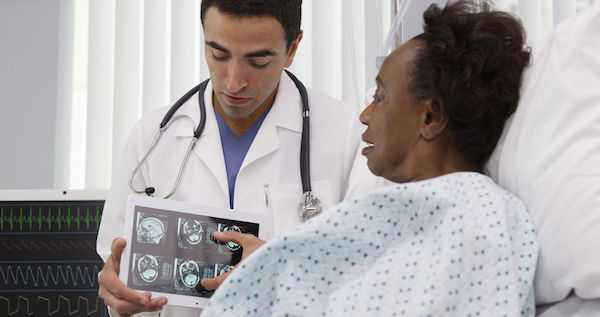A concussion is a common type of traumatic brain injury (TBI) and is frequently seen in players of contact sports.

The brain is protected from light trauma and day-to-day bumps by the cerebrospinal fluid within the skull. Sometimes though, this protective mechanism is unable to cushion it from more severe jolts and impacts. A concussion describes a type of trauma to the brain that can temporarily affect its functioning.
Concussion causes can include blows to the head, such as may be incurred in contact sports or a fall, but even accelerating or decelerating the head suddenly (for example, being violently shaken or the impact of a car accident) can cause the brain to forcefully hit the walls of the skull.
What are its symptoms?
Signs of concussion may be mild or come on hours or even weeks after the causative injury or they may come on rapidly.
Concussion symptoms include:
- Headache
- Loss of consciousness may occur but it is important to note that a person may be concussed from an injury even if they didn’t pass out
- Dizziness
- Nausea and vomiting
- Post-traumatic amnesia
- Confusion and difficulty staying focused
- Ringing in the ears
- Drowsiness and fatigue
- Slurring of speech
- Visual disturbances
- Sensitivity to light or sound
- Disruptions to motor coordination
- Inability to balance
- Differences in personality or behavioural changes, including moodiness, diminished interest in favourite activities, tearfulness and inappropriate displays of emotion.
How is it diagnosed?
It’s vital to seek medical assistance after any significant head trauma, so that serious injury such is bleeding on the brain can be ruled out, which may require imaging tests such as an X-ray.
A concussion diagnosis will usually be based on a neurological examination in which reflexes, coordination, balance, vision and hearing, and cognitive skills will be assessed. The doctor may grade a concussion as a Grade 1, 2 or 3 (mild, moderate or severe) based on whether or not the person lost consciousness and on symptoms of amnesia and loss of equilibrium. People who have sustained a Grade 3 concussion may be kept in hospital overnight for observation.
What are your treatment options?
There is no medical intervention that can cure a concussion. Concussion treatment is focused primarily on resting and ‘taking it easy’, both physically and mentally, until the injury has had time to resolve.
It’s essential to avoid physical exertion until all the symptoms have passed, even if this takes weeks, as your brain is more vulnerable during this healing period and getting another concussion during this time can lead to deadly brain swelling (second-impact syndrome).
Your doctor may recommend painkillers to deal with the symptoms of post-traumatic headache – make sure to use one that is aspirin-free to minimise the risk of bleeding within the skull.
Can it be prevented?
The key to concussion prevention is taking the necessary precautions to reduce your risk of head injury, particularly if engaging in activities that may be deemed high risk, such as playing contact sports. This may include wearing protective headgear – not just for sports like rugby, but also for activities such as riding a motorbike or bicycle.
Another common-sense way to minimise your risk of concussion is always buckling your seatbelt (make sure your children do the same) and reducing risk in your home by making sure there are no trip hazards, etcetera.
For more info
Sports Concussion South Africa
IMAGE CREDIT: 123rf.com
